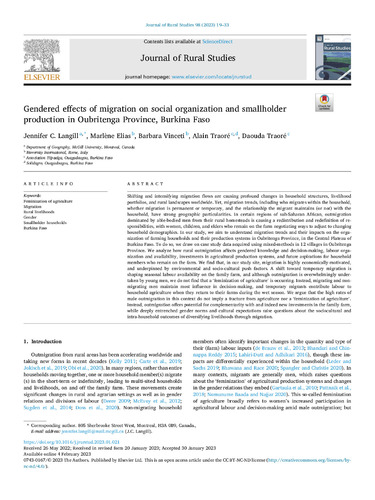Gendered effects of migration on social organization and smallholder production in Oubritenga Province, Burkina Faso
Abstract
Shifting and intensifying migration flows are causing profound changes in household structures, livelihood portfolios, and rural landscapes worldwide. Yet, migration trends, including who migrates within the household, whether migration is permanent or temporary, and the relationship the migrant maintains (or not) with the household, have strong geographic particularities. In certain regions of sub-Saharan African, outmigration dominated by able-bodied men from their rural homesteads is causing a redistribution and redefinition of responsibilities, with women, children, and elders who remain on the farm negotiating ways to adjust to changing household demographics. In our study, we aim to understand migration trends and their impacts on the organization of farming households and their production systems in Oubritenga Province, in the Central Plateau of Burkina Faso. To do so, we draw on case study data acquired using mixed-methods in 12 villages in Oubritenga Province. We analyze how rural outmigration affects gendered knowledge and decision-making, labour organization and availability, investments in agricultural production systems, and future aspirations for household members who remain on the farm. We find that, in our study site, migration is highly economically-motivated, and underpinned by environmental and socio-cultural push factors. A shift toward temporary migration is shaping seasonal labour availability on the family farm, and although outmigration is overwhelmingly undertaken by young men, we do not find that a ‘feminization of agriculture’ is occurring. Instead, migrating and non-migrating men maintain most influence in decision-making, and temporary migrants contribute labour to household agriculture when they return to their farms during the wet season. We argue that the high rates of male outmigration in this context do not imply a fracture from agriculture nor a ‘feminization of agriculture’. Instead, outmigration offers potential for complementarity with and indeed new investments in the family farm, while deeply entrenched gender norms and cultural expectations raise questions about the sociocultural and intra-household outcomes of diversifying livelihoods through migration.

